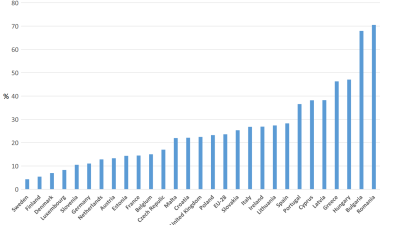by John Welshman, Lancaster University
In December 2011, the Prime Minister announced the Government would 'get to grips' with England's alleged 120,000 'most troubled families'. Yet the label is hardly new. Historical investigation indicates striking similarities between today’s focus on ‘troubled families’ and a debate about ‘problem families’ that in fact began in the 1940s. Each of the criticisms of the Government’s current initiative - the way troubled families are defined, the flimsy evidence, the claim there are as many as 120,000 such families, the alleged £9 billion cost to the state and the elision between ‘troubled’ and ‘troubling’ – are part of a debate that has been going since at least the Second World War.
Throughout this history, describing the problem family has been easier than defining it. As today, it was claimed in the 1940s that a small number of families were responsible for a high proportion of social problems. The Our Towns report of 1943, for example, claimed that problem families were ‘on the edge of pauperism and crime, riddled with mental and physical defects, in and out of the courts for child neglect, a menace to the community, of which the gravity is out of all proportion to their numbers’.
The Eugenics Society argued that problem families had four main features: ‘intractable ineducability’, ‘instability or infirmity of character’, ‘the presentation by the family of multiple social problems’, and ‘a squalid home’.
By the early 1950s, it was thought that problem families comprised 1to2 per cent of families in most areas, and the consensus was that the problem was not poverty. But again, as today, the concept was questioned by practitioners and social scientists. In 1954, Elizabeth Irvine, a Psychiatric Social Worker, wrote that ‘problem families are easy to recognise and describe, but surprisingly hard to define’.
Noting that the evidence was impressionistic, Our Towns had argued that a social survey of ‘this class of the population’ was seriously needed. A Problem Families Committee set up by the Eugenics Society in the late 1940s recommended a national survey and organised pilot enquiries. It set out to survey problem families in six areas –Bristol, Warwickshire, Luton, Rotherham, the West Riding of Yorkshire and Kensington.
Local authorities were asked to collect lists of families that presented multiple problems. These were to be returned to the local Medical Officer of Health (MOH) who would prepare a complete list. In a striking parallel with today, a list of ‘possible problem families’ would be compiled; a sample selected for more intensive study and visiting; and a list of 50 to 100 ‘authentic problem families’ agreed. However even those involved had doubts about the methodology – the MOH for Bristol admitted that ‘the method tried out has not been a complete success’. By 1957, critics were writing about the problem of the ‘problem family’. Barbara Wootton suggested in 1959 that work had not ‘advanced beyond the descriptive stage, establishing the recurrences of recognisable syndromes of problem behaviour’.
Troubled or Troubling?
As today, commentators elided troubled and troubling. The problem families were seen both as a threat to themselves and to others. An observer in Luton wrote in 1946 that problem families were those which ‘for their own well-being or the well-being of others, for reasons primarily unconnected with old age, accident, misfortune, illness or pregnancy, require a substantially greater degree of supervision and help over longer periods than is usually provided by existing social services’. The MOH for Bristol later wrote they were those ‘with social defectiveness of such a degree that they require care, supervision and control for their own well-being or for the well-being of others’.
Nevertheless despite the critique, the problem family became policy. In July 1950, a circular from the Home Office sought to tackle child neglect, and avoid the need to remove children from their homes. In 1954, it was suggested that local authorities should use health visitors and home helps to tackle problem families. Henceforth, this area of social welfare was included in the work of local Health Departments – the forerunners of the Troubled Families Units at the local level today. The MOH for the West Riding of Yorkshire anticipated Louise Casey by 60 years when he wrote in 1946 ‘what is required is someone who will take off his coat and get down to restitution of civilised conditions’. Local authorities sent selected problem families for rehabilitation in residential institutions. The Brentwood Recuperation Centre for Mothers and Children, south of Manchester, closed its doors only in 1970.
The cycle of the ‘Problem Family’?
Policies were motivated by the strong belief in intergenerational continuities. In Sheffield, the Health Department carried out follow-up studies on the families they had identified in the 1950s, in 1967 and 1971. In 1971, the authors noted that ‘articles commonly found in households where the family income does not cover bare necessities because of heavy debts, include tape recorders, radiograms, cocktail cabinets, and quite often one or more large pedigree dogs’. Moreover there was particular concern about large families and reproduction. Segregation and sterilisation had been suggested as solutions in the 1940s. In 1968, the Chief Medical Officer wrote that family planning was particularly important for families characterised by ‘squalor, ill-health, an inability to cope and limited intelligence’.
There is a clear pattern in this development, one that follows a trajectory or arc. These socially-constructed concepts:
- come to prominence, often by the invoking of a sense of danger or anxiety
- enjoy a period of popularity, in terms of the popular media
- influence policy and its implementation
- gain a pejorative connotation
- fade way
- are replaced by a successor term
With regard to the Government’s focus on troubled families, previous experience indicates that we are currently moving towards the top of that arc. That is, troubled families have become over the past year part of policy rhetoric and policy implementation. There are therefore very striking continuities between attitudes, policies, and descriptions of families deemed problem in the 1950s, and troubled in 2012. Thus the problem family of the 1950s became the underclass of the 1980s, and now the troubled family of today.
John Welshman is Senior Lecturer in History at Lancaster University, UK. A longer piece, ‘Troubled Families’: the lessons of history, 1880-2012, has been published in History & Policy.



 PSE:UK is a major collaboration between the University of Bristol, Heriot-Watt University, The Open University, Queen's University Belfast, University of Glasgow and the University of York working with the National Centre for Social Research and the Northern Ireland Statistics and Research Agency. ESRC Grant RES-060-25-0052.
PSE:UK is a major collaboration between the University of Bristol, Heriot-Watt University, The Open University, Queen's University Belfast, University of Glasgow and the University of York working with the National Centre for Social Research and the Northern Ireland Statistics and Research Agency. ESRC Grant RES-060-25-0052.






